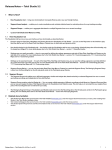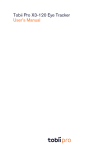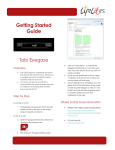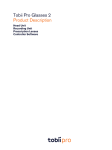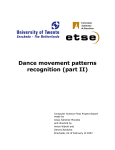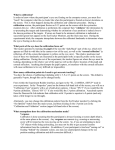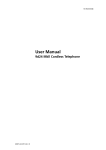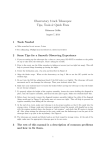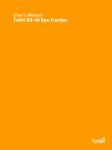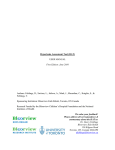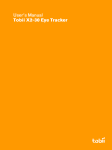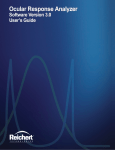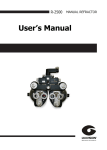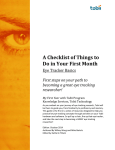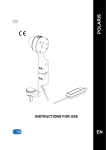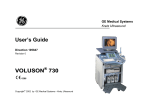Download Tobii Pro X3–120 Eye Tracker (preliminary) Product Description
Transcript
Tobii Pro X3–120 Eye Tracker (preliminary) Product Description Preliminary Product Description Tobii Pro X3–120 Eye Tracker (preliminary) Version 1.0 07/2015 All rights reserved. Copyright © Tobii AB (publ) The information contained in this document is proprietary to Tobii Technology. Any reproduction in part or whole without prior written authorization by Tobii Technology is prohibited. Products that are referred to in this document may be either trademarks and/or registered trademarks of the respective owners. The publisher and the author make no claim to these trademarks. While every precaution has been taken in the preparation of this document, the publisher and the author assume no responsibility for errors or omissions, or for damages resulting from the use of information contained in this document or from the use of programs and source code that may accompany it. In no event shall the publisher and the author be liable for any loss of profit or any other commercial damage caused or alleged to have been caused directly or indirectly by this document. Content subject to change without notice. Please check Tobii web site www.tobii.com for updated versions of this document. Table of Contents 1 Introduction.................................................................................................................................... 1 1.1 1.2 1.3 2 Technical Specifications ................................................................................................................ 2 2.1 3 4 Overview...............................................................................................................................1 Applications Areas .................................................................................................................1 Basic Operating Principles ......................................................................................................1 Tobii Pro X3–120 Eye Tracker Specifications (preliminary) ..........................................................2 Data Output ................................................................................................................................... 5 Eye Tracking Setups ...................................................................................................................... 6 4.1 4.2 Appendix A Appendix B B1 B2 Appendix C C1 C2 C3 Typical Tobii Pro X3–120 Eye Tracker Screen Setups ................................................................6 4.1.1 Local Live Viewer ....................................................................................................6 Typical Tobii Pro X3–120 Eye Tracker Physical Object Setup ......................................................7 4.2.1 External video stimulus recording ..............................................................................7 Glossary .......................................................................................................................... 8 Accuracy and Precision Measurements ........................................................................... 9 Gaze Precision.......................................................................................................................9 Gaze Accuracy ......................................................................................................................9 Safety and Compliance ................................................................................................. 10 Safety .................................................................................................................................10 C1.1 Mounting Warning.................................................................................................10 C1.2 Emergency Warning ..............................................................................................10 C1.3 Infrared Warning ...................................................................................................10 C1.4 Epilepsy Warning ..................................................................................................10 C1.5 Magnetic Field Warning .........................................................................................10 C1.6 Child Safety .........................................................................................................11 C1.7 Do not Open the Tobii Pro X3–120 .........................................................................11 C1.8 Environment .........................................................................................................11 Compliance Information ........................................................................................................11 C2.1 FCC Statement.....................................................................................................11 C2.2 Industry Canada Statement ....................................................................................11 C2.3 CE Statement .......................................................................................................12 C2.4 Standards ............................................................................................................12 C2.5 Disposing of the Tobii Pro X3–120..........................................................................12 Other limitations and considerations .......................................................................................12 C3.1 Intended use ........................................................................................................12 C3.2 Light conditions ....................................................................................................12 C3.3 Eyelashes.............................................................................................................12 C3.4 Droopy eyelids ......................................................................................................12 C3.5 Keeping Tobii Pro X3–120 firmware up to date .........................................................13 1 1.1 Introduction Overview This document describes the features and functionality of the Tobii Pro X3–120 Eye Tracker. The Tobii Pro X3–120 is a stand alone eye tracker that can be used in various setups by attaching it to monitors, laptops or for performing eye tracking on physical objects. The eye tracker requires some assembly before first time use and after transport. The Tobii Pro X3–120 Eye Tracker is an unobtrusive eye tracker for detailed research of natural behavior. Its large head movement box allows the subject to move during recording while maintaining accuracy and precision. The Tobii Pro X3–120 Eye Tracker offer maximum flexibility with numerous software and stimuli set-up options. The Tobii Pro X3-120 has a sampling rate of 120Hz. The Tobii Pro X3–120 is a compact and light weight eye tracker measuring only 324 mm (12.7’’) in length and only 118 grams (4.2 Oz) in weight. It enables your portable eye tracking lab and studies that require an eye tracker to track even large objects at close distances. Use the eye trackers to conduct studies on: • • • • • • 1.2 Laptops PC monitors up to app. 25″ (16:9) Mobile devices Real-world interfaces Projections, simulators TV screens Applications Areas The modular system can be used both in screen and real-world test scenarios, making way for a very broad spectrum of studies. You can mount the eye tracker on a laptop, a PC monitor, an all-in-one PC, or even a tablet. Present your stimuli using a projection or TV. You can study real-world interfaces like a control panel, an ATM or a store shelf. The supplied mounting solutions support a variety of study designs. Tobii Pro X3–120 Eye Tracker — is designed for studies aimed at determining precisely where the participants are looking and for studying and measuring eye fixations and other eye tracking metrics based on these. 1.3 Basic Operating Principles During tracking, Tobii Pro Eye Trackers use infrared diodes to generate reflection patterns on the corneas of the subject’s eyes. These reflection patterns, together with other visual data about the subject, are collected by the image sensor. Sophisticated image processing algorithms identify relevant features, including the eyes and the corneal reflection patterns. Complex mathematics is used to calculate the 3D position of each eyeball, and finally the gaze point on the screen; in other words, where the subject is looking. Tobii Eye Trackers are designed for use in indoor office environments with adult participants. Tobii Pro X3–120 Eye Tracker (preliminary) Product Description v.1.0 - enUS 1 Introduction 1 2 Technical Specifications The characteristics of an eye tracker can be described in terms of gaze accuracy and gaze precision. Accuracy describes the angular average distance from the actual gaze point to the one measured by the eye tracker. Gaze precision describes the spatial variation between successive samples collected when the subject fixates at a specific point on a stimuli. More information regarding the accuracy and precision measurements can be found in Appendix B Accuracy and Precision Measurements, page 9 in tests reports available on the Tobii Pro web site. A glossary can be found at Appendix A Glossary, page 8. 2.1 Tobii Pro X3–120 Eye Tracker Specifications (preliminary) Table 2.1 Gaze Accuracy (preliminary) Gaze accuracy1 Tobii Pro X3-120 Eye Tracker (firmware version — 1.6.0 — preliminary data) Binocular Monocular At ideal conditions 0.4 NA At 25° gaze angle NA NA At 30° gaze angle NA NA At 1 lux NA NA At 300 lux NA NA At 600 lux NA NA At 1000 lux NA NA White stimuli background NA NA 1. Accuracy under ideal conditions is measured in the center of the head movement box with the participant fixed in a chinrest. Data is collected immediately after calibration in a controlled laboratory environment with constant illumination with 9 stimuli points at gaze angles of ≤20º. Table 2.2 Gaze Precision (preliminary) Gaze precision at ideal conditions Tobii Pro X3-120 Binocular Monocular Artificial Eye NA NA Human Eye 0.23 NA Table 2.3 Eye Tracking Specifications (preliminary) Eye Tracking Specifications Tobii Pro X3-120 Eye Tracker 120 Hz Sampling rate (std. dev. approx. 0.03 Hz) Eye tracking technique Corneal reflection, dark and bright pupil combination Binocular tracking Yes Pupil measurement No Total system latency 12 ms Time to tracking recovery For blinks: immediate After lost tracking: <100 ms 2 2 Technical Specifications Tobii Pro X3–120 Eye Tracker (preliminary) Product Description v.1.0 - enUS Tobii Pro X3-120 Eye Tracker Eye Tracking Specifications Head movement1 Freedom of head movement at 80 cm (width x height) 50 cm x 40 cm (19.7″ x 15.7″) Operating distance (eye tracker to participant) 50 – 90 cm (19.6″ – 35.4″) Recommended screen size Up to 25″ (16:9) Data sample output Timestamp, eye position, gaze point, validity code 1. Freedom of head movement describes the volume in front of the tracker in which the user must have at least one of the eyes. The numbers are specified parallel/orthogonal to screen surface, assuming the eye tracker is at a 20 degree angle to the screen. Table 2.4 Eye Tracking Unit Eye Tracking Unit Tobii Pro X3-120 Eye Tracker Eye tracker processing On Windows PC or External Processing Unit (accessory) Connectors USB 3.0 (with BC 1.2), LAN with External Processing Unit (accessory) Weight 118 g (4.2 oz) Size 324 x 20 x 17 mm (12.7 x 0.8 x 0.7″) Mounting solutions Adhesive Mounting brackets for monitors, laptops and tablets. Desk Stand Accessory package for Tripods and desks. Table 2.5 Tobii Pro X3-120 Eye Tracker External Processing Unit (accessory) Connectors USB 3.0, LAN and power connector Size NA Weight NA Table 2.6 Hardware package content Tobii Pro X3-120 Eye Tracker 4 x Adhesive mounting brackets for permanent installation. 2 x Mounting bracket adapters for existing Tobi Pro X2–30/60 adhesive mounting brackets. Safety Instructions and Installation Guide USB cable Travel Case Cleaning Wipe Tobii Pro X3-120 Eye Tracker USB memory stick containing the Tobii Pro X3–120 installer, documentation and training video. Tobii Pro X3-120 Eye Tracker user manual (pdf) Table 2.7 Accessories Tobii Pro X3-120 External Processing Unit Tobii Mobile Device Stand for X2 Additional Mounting Brackets Tobii Pro X3–120 Eye Tracker (preliminary) Product Description v.1.0 - enUS 2 Technical Specifications 3 Table 2.8 Compliance Ingress protection IP class 20 CE - European Union Yes FCC - USA Yes IC - Canada Yes RCM - Australia Yes Eye Safety IEC/EN 62471:2008 Yes Electrical safety IEC 60950–1:2005 Yes RoHS 2 Yes WEEE — European Union Yes Table 2.9 Compatible software Tobii Studio 3.3.1 or later. Tobii Analytics SDK 3.0.83 or later. Other applications built on the Tobii Analytics SDK 3.0.83 or later. Table 2.10 Minimum system requirements Operating system Windows 7, Windows 8.1 (64–bit) CPU Intel Core i7 (4 cores), 2.0 GHz RAM 8 Gb Connectors 1 x USB 3.0 with the latest driver and with BC 1.2 or 1 x Gigabit LAN port for External Processing Unit (accessory). 4 2 Technical Specifications Tobii Pro X3–120 Eye Tracker (preliminary) Product Description v.1.0 - enUS 3 Data Output Different applications can be connected as clients to the eye tracker to, e.g., gather eye gaze data in real-time and perform calibrations. Applications that can be used together with the eye tracker include the Tobii Studio software, third party software products, or your own custom software based on the Tobii Software Development Kit. For more information about the supported software products please refer to the product descriptions and documentation for the respective products. Below is a summary of the data that the eye tracker outputs. Please note that the parameter names, definitions and coordinate systems may differ depending on the software used, please refer to the software documentation for additional information. Timestamp Timestamp in microseconds from the eye tracker’s internal clock. Additional timestamps are available in Tobii Studio. Gaze Point Left X, Y Horizontal (X) and vertical (Y) coordinates of the gaze point for the left eye. Available in different coordinate systems in Tobii Studio and the Tobii Analytics Software Development Kit. Eye Position Left X, Y, Z The 3D position of the left eye in relation to the eye tracker. Available in different coordinate systems in Tobii Studio and the Tobii Analytics Software Development Kit. Validity Code Left Indicates the confidence level that the left eye has been correctly identified by the eye tracker. Gaze Point Right X, Y Horizontal (X) and vertical (Y) coordinates of the gaze point for the right eye. Available in different coordinate systems in Tobii Studio and the Tobii Analytics Software Development Kit. Eye Position Right X, Y, Z The 3D position of the right eye in relation to the eye tracker. Available in different coordinate systems in Tobii Studio and the Tobii Analytics Software Development Kit. Validity Code Right Indicates the confidence level that the right eye has been correctly identified by the eye tracker. Tobii Pro X3–120 Eye Tracker (preliminary) Product Description v.1.0 - enUS 3 Data Output 5 4 Eye Tracking Setups This chapter describes typical setup configurations that can be used with the Tobii Pro X3–120 Eye Tracker. For specific information about custom configurations or system requirements and recommendation, please contact your Tobii Pro sales representative or Tobii Pro technical support. The System Requirements and Recommendations document can be downloaded at www.tobiipro.com. Your particular needs might differ from these typical configurations. More detailed information is available in the Eye Tracker User Manual provided with the product. 4.1 Typical Tobii Pro X3–120 Eye Tracker Screen Setups These basic setups are the simplest setups when using on screen stimuli, such as images, movies or web. To record the participant’s reactions, the conversation between the test leader and test participant, you need to connect an external user camera and microphone to the computer running Tobii Studio. The setups below do not include the user camera and user sound. Single Screen Setups 4.1.1 Local Live Viewer The setup below is used when the test is to be supervised from a separate screen where the test leader can see the eye movements of the subject in real time during testing. Local Live Viewer Setups 6 4 Eye Tracking Setups Tobii Pro X3–120 Eye Tracker (preliminary) Product Description v.1.0 - enUS 4.2 Typical Tobii Pro X3–120 Eye Tracker Physical Object Setup When studying a stimuli that doesn’t have a screen or when studying an external device such as a mobile phone, a physical object setup needs to be used where a video or web camera captures the image of the stimuli. To record the participant’s reactions, the conversation between the test leader and test participant, you need to connect an additional camera and microphone to the computer running Tobii Studio. The setups below do not include the user camera and user sound. Physical Object Setup 4.2.1 External video stimulus recording This setup is suitable when using a Tobii Eye Tracking system for eye tracking data analysis when the stimulus is presented from a separate computer or other RGB or VGA sources. This could include a computer game, a DVD player, or when stimulus is presented on a computer running a different operating system. The computer running Tobii Studio must be equipped with an additional video capture card. Note that if the external application runs on the Windows operating system, and it does not use 3D graphics acceleration or it does not have a high processor load and high memory usage, it may be more suitable and less complex to instead run this on the same computer as Tobii Studio and use the Screen Recording option in Tobii Studio. For this setup, the image from the Tobii Studio computer has to be displayed on the screen during calibration (to display the calibration points). The external stimulus computer, however, should be shown on the screen during the actual test. Both devices must therefore be connected to the same screen. To switch between the inputs, use a switch or a screen that allows for multiple input sources. The image shown on the screen must be sent to Tobii Studio to record the video stream and synchronize it with the gaze data. If the stimulus is presented from an analogue video source, e.g., a VCR or an analogue video camera, a similar setup with slightly modified components can be used. External Video Stimulus Recording Setup Tobii Pro X3–120 Eye Tracker (preliminary) Product Description v.1.0 - enUS 4 Eye Tracking Setups 7 Appendix A Glossary Monocular/ binocular Monocular data shown is based on data from the participant’s dominant eye only. Binocular data is the average of the two eyes. Gaze precision Describes the spatial angular variation between a set of consecutive gaze samples. Gaze precision can be measured under various conditions. Gaze accuracy Describes the angular average distance from the actual gaze point to the one measured by the eye tracker. Gaze accuracy can be measured under various conditions. Sampling rate Number of eye tracking data samples per second. Total system latency The duration from mid-point of the eye image exposure, to when a sample is available via the API on the client computer. This includes half of the image exposure time plus image read-out and transfer time, processing time and time to transfer the data sample to a client computer. Time to tracking recovery for blinks When a participant blinks, the eye tracker loses the ability to track eye gaze because the eye is covered by the eyelid. If the pupil is occluded for only a short period, the system will regain tracking immediately when the pupil becomes visible again, but only if the participant has maintained approximately the same head position during the blink. Data during blinks are only lost when the pupil is occluded, i.e. during the eyelid movement itself or when the eye is closed. Time to tracking recovery after lost tracking An eye tracker working in a natural user environment may occasionally lose track of the participant’s eyes, e.g., when the participant completely turns away from the tracker. If a period of a few hundred milliseconds elapses during which the eye tracker is unable to detect the eyes in close proximity to where they were last detected, the eye tracker will start searching for the eyes within the entire head movement box. The stated measurement is the typical time to tracking recovery in such a situation. If the eye tracker is unable to detect the eyes of the participant even after about one minute, the system will enter a “slow search” mode, leading to larger recovery times. Freedom of head movement Describes an area ( width x height in cm) where at least one eye is within the eye tracker’s field of view. Operating distance Describes the range of distances (minimum and maximum) between the participant’s eyes and the surface covering the eye tracker sensors at which eye tracking can be done while maintaining tracking. Eye tracking processing unit Gaze data calculations are performed by firmware embedded in the eye tracker or in a separate processing unit. 8 Appendix A Glossary Tobii Pro X3–120 Eye Tracker (preliminary) Product Description v.1.0 - enUS Appendix B Accuracy and Precision Measurements Gaze accuracy and precision are typically measured in degrees of visual angle. One degree accuracy corresponds to an average error of 12 mm (0.47’’) on a screen at a distance of 65 cm (27’’). Data is presented as monocular or binocular. Monocular data is based on data from the subject’s dominant eye only. Binocular data is the average of both eyes. B1 Gaze Precision Precision measurements are done using artificial eyes to eliminate artifacts from human eye movements. Tobii specifies precision both with and without noise reduction filters. All measurements are done at the default sampling rate of the eye tracker and at the optimum distance between the eye tracker and the subject. Precision is calculated as root-mean-square (RMS) of successive samples. As the distance from the eye tracker influences precision, measurements are also taken at various distances. Data from these measurements is binocular. B2 Gaze Accuracy Accuracy under ideal conditions is measured in the center of the head movement box with the subject fixed in a chinrest. Data is collected immediately after calibration, in a controlled laboratory environment with constant illumination, with 9 stimuli points at gaze angles ≤20º. Measurements are done on 20 test subjects without lenses, glasses or droopy eyelids. Accuracy for one subject is calculated as the mean of several data samples for several stimuli points across a screen. The accuracy figure presented is the mean accuracy from all subjects. Good accuracy is difficult to achieve at large gaze angles, but is important when testing large stimuli. For instance, the upper corner of a 23’’ screen with the test subject at a distance of 65 cm (26’’) from the eye tracker corresponds to a 32º visual angle from the center of the eye tracker unit. Consequently, measurements are also presented for stimuli presentations at large gaze angles. When luminance of the stimuli or the illumination in the lab changes, the size and shape of the pupil is affected. Unless compensated for, this may cause a significantly reduced accuracy. Testing the influence of surrounding light and stimuli luminance on accuracy is done in a laboratory environment with controlled light conditions. Stimuli points are presented on a black background so as not to influence ambient light conditions. Testing is also done with ambient light at a level deemed ‘normal’ office lighting where the background is changed to white with black stimuli points. The results from a test in which the background was changed has been referred to as Drift in previous Tobii product description documents. As with precision, the distance from the eye tracker influences accuracy. When testing this influence, calibration is done with the subject in the center of the head movement box (i.e. at a distance of 65 cm) and measurements are done thereafter. Measurements are performed with the test subject at precise and specific distances relative to the eye tracker, measured along the axis of the tracking sensors. Data from these measurements is binocular. Tobii Pro X3–120 Eye Tracker (preliminary) Product Description v.1.0 - enUS Appendix B Accuracy and Precision Measurements 9 Appendix C C1 C1.1 Safety and Compliance Safety Mounting Warning The Tobii Pro X3–120 should be mounted according to MANUFACTURER instructions of approved mounts. Tobii AB or its agents are not liable for damage or injuries to a person or its property due to a Tobii Pro X3–120 falling from a mounted configuration. The mounting of a Tobii Pro X3–120 is done entirely at the user’s own risk. The double sided tape supplied with the adhesive Magnetic Mounting Plates is designed to permanently attach the bracket to the monitor/laptop. Attempting to remove the bracket after attaching it using the supplied tape can result in damage both to the monitor/laptop and the bracket. Do not lick the tape or place any part of the tape or Magnetic Mounting Plate in one's mouth. Do not mount the Tobii Pro X3–120 on monitors positioned above the head or face of a users unless using a dedicated "fixed mounting" solution. C1.2 Emergency Warning The Tobii Pro X3–120 system is to be used for research purposes only. Be aware that due to the low, but possible risk of failure or distraction, the Tobii Pro X3–120 should not be relied upon or used in dangerous or otherwise critical situations. C1.3 Infrared Warning When activated, the Tobii Pro X3–120 emits pulsed infrared (IR) light. Certain medical devices are susceptible to disturbance by IR light and/or radiation. Do not use the Tobii Pro X3–120 when in the vicinity of such susceptible medical devices as their accuracy or proper functionality could be inhibited. C1.4 Epilepsy Warning Some people with Photosensitive Epilepsy are susceptible to epileptic seizures or loss of consciousness when exposed to certain flashing lights or light patterns in everyday life. This may happen even if the person has no medical history of epilepsy or has never had any epileptic seizures. A person with Photosensitive Epilepsy would also be likely to have problems with TV screens, some arcade games, and flickering fluorescent bulbs. Such people may have a seizure while watching certain images or patterns on a monitor, or even when exposed to the light sources of an eye tracker. It is estimated that about 3-5% of people with epilepsy have this type of Photosensitive Epilepsy. Many people with Photosensitive Epilepsy experience an "aura" or feel odd sensations before the seizure occurs. If you feel odd during use, move your eyes away from the eye tracker. C1.5 Magnetic Field Warning The Tobii Pro X3–120 Magnetic Mounting Plates contains magnets. Magnetic fields may interfere with the function of cardiac pacemakers and implantable cardioverter-defibrillators. As a general rule, maintain a minimum distance of 6 inches (15 centimeters) between any item with magnets and your heart device. The magnets can also shut off the monitor on a laptop if the laptop is equipped with a magnetic sensor to switch off the monitor when closing the laptop. If this happens, shut of the sensor on the laptop. 10 Appendix C Safety and Compliance Tobii Pro X3–120 Eye Tracker (preliminary) Product Description v.1.0 - enUS C1.6 Child Safety The Tobii Pro X3–120 is an advanced computer system and electronic device. As such it is composed of numerous separate, assembled parts. In the hands of a child certain of these parts have the possibility of being separated from the device, possibly constituting a choking hazard or another danger to the child. Young children should not have access to, or the use of, the device without parental or guardian supervision. C1.7 Do not Open the Tobii Pro X3–120 Non-compliance will result in loss of Warranty! There are no user serviceable components inside. Contact Tobii Pro Support if your Tobii Pro X3–120 is not working properly. C1.8 Environment The Tobii Pro X3–120 system is designed for use in dry indoor environments. Avoid any exposure to direct sunlight as this will affect eye tracking quality and longer exposure can overheat the equipment. Avoid exposure to any liquids, gels, moist, rain, sweat or other damp materials or environments. Do not use the eye tracker near water — the device is not water resistant. The device complies with IP Class 20 and has no protection against objects smaller than 5 mm. Keep the eye tracker in a clean and dust free environment. When using the equipment take adequate precautions against dust and dirt. Do not place or use the equipment in places subject to extreme temperatures and humidity, such as on top of and or near a heating element, in a hot or damp room, or in a hot automobile in the sun. C2 Compliance Information All Tobii Pro X3–120 are CE-marked, indicating compliance with the essential health and safety requirements set out in European Directives. C2.1 FCC Statement This device complies with Part 15 of the FCC Rules. Operation is subject to the following two conditions: (1) this device may not cause harmful interference, and (2) this device must accept any interference received, including interference that may cause undesired operation. Modifications not expressly approved by Tobii AB could void the user’s authority to operate the equipment under FCC rules. This equipment has been tested and found to comply with the limits for a Class B digital device, pursuant to part 15 of the FCC Rules. These limits are designed to provide reasonable protection against harmful interference in a residential installation. This equipment generates, uses and can radiate radio frequency energy and, if not installed and used in accordance with the instructions, may cause harmful interference to radio communications. However, there is no guarantee that interference will not occur in a particular installation. If this equipment does cause harmful interference to radio or television reception, which can be determined by turning the equipment off and on, the user is encouraged to try to correct the interference by one or more of the following measures: • • • • C2.2 Reorient or relocate the receiving antenna. Increase the separation between the equipment and receiver. Connect the equipment into a wall outlet on a circuit different from that to which the receiver is connected. Consult the dealer or experienced radio/TV technician for assistance. Industry Canada Statement This Class B digital apparatus complies with Canadian ICES-003. Cet appareil numérique de la classe B est conforme à la norme NMB-003 du Canada. Tobii Pro X3–120 Eye Tracker (preliminary) Product Description v.1.0 - enUS Appendix C Safety and Compliance 11 C2.3 CE Statement The Tobii Pro X3–120 complies with the following Directives: • • C2.4 2011/65/EU (RoHS 2) - Restriction of Hazardous Substances Directive 2004/108/EC (EMC) - Electromagnetic Compatibility Directive Standards The Tobii Pro X3–120 complies with the following standards: • • IEC/EN 62471:2008, Photo Biological Safety of Lamps and Lamp Systems EMC Emission: EN 61000-6-3:2007, Generic Emission standard for residential, commercial and light industry environments • EMC Immunity: EN 61000-6-1:2007, Generic Emission standard for residential, commercial and light industry environments • • • C2.5 EN 55024:1998+A1+A2, Information technology equipment. Immunity characteristics. Limits and methods of measurement IEC 60950–1:2005, Safety of information technology equipment FCC part 15, Class B Disposing of the Tobii Pro X3–120 Do not dispose of the Tobii Pro X3–120 in general household or office waste. Follow your local regulations for the disposal of electrical and electronic equipment. C3 C3.1 Other limitations and considerations Intended use The Tobii Pro X3–120 is intended to be used in research activities about human behavior including eye movements, involving adult participants in a dry and dust free indoor environment. The product should only be used as described in the User’s Manual. Please read the User’s Manual and other supplied documentation thoroughly before using the product. C3.2 Light conditions We recommend that eye tracking studies be performed in a controlled and well-lit environment. Sunlight should be avoided since it contains high levels of infrared light which will interfere with the eye tracker system. Sunlight affects eye tracking performance severely and longer exposure can overheat the eye tracker. The eye tracker is not designed for exposure to (direct) sunlight. Eye tracking generally does not work in strong direct sunlight. Shielding the eye tracker adequately from the sun may prevent sunlight from interfering with eye tracking. For better performance, use the supplied tinted lenses if the product is used in an environment with strong sunlight.. C3.3 Eyelashes Long eyelashes can be obstructive when the participant’s eyes are less open, especially if the participant is wearing mascara. In rare cases, eyelashes may completely block the view of the participant’s pupils, making eye tracking impossible. C3.4 Droopy eyelids Droopy eyelids or otherwise obstructive eyelids can block the view of the participant’s pupils. In rare cases, such eyelids may completely block the view of the participant’s pupils, making eye tracking impossible. 12 Appendix C Safety and Compliance Tobii Pro X3–120 Eye Tracker (preliminary) Product Description v.1.0 - enUS C3.5 Keeping Tobii Pro X3–120 firmware up to date From time to time Tobii Pro will release updates for the eye tracker firmware that will improve performance and/or introduce new functionality. The latest firmware can be downloaded from the Tobii Pro Support website http://www. tobii.com/analysissupport Make sure to regularly check for and update to the latest version of the software and firmware. Tobii Pro X3–120 Eye Tracker (preliminary) Product Description v.1.0 - enUS Appendix C Safety and Compliance 13 Tobii Pro X3–120 Eye Tracker (preliminary) Product Description v.1.0 - en-US ©Tobii®. Illustrations and specifications do not necessarily apply to products and services offered in each local market. Technical specifications are subject to change without prior notice. All other trademarks are the property of their respective owners. Tobii Pro Support EUROPE / GLOBAL Phone (SWE): +46 8 522 950 10 Phone (GER): +49 69 24 75 03 4-27 [email protected] Support hours: 8 am - 6 pm Between July-August: 9am - 5pm (Central European Time, GMT +1) NORTH AMERICA Phone: +1 703 738 1320 JAPAN Phone: +81 3 5793 3316 CHINA Phone: +86 180 1558 5168 [email protected] Support hours: 8 am - 8 pm (US Eastern Standard Time, GMT -6) [email protected] Support hours: 9 am - 5.30 pm (Japan Standard Time, GMT +9) [email protected]


















